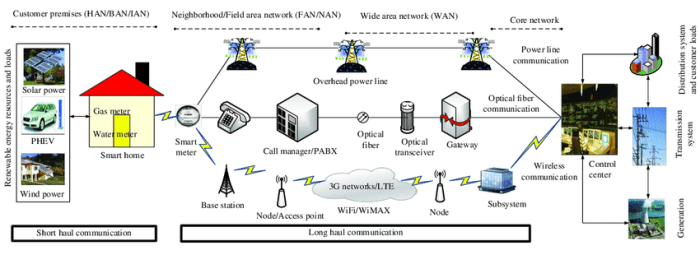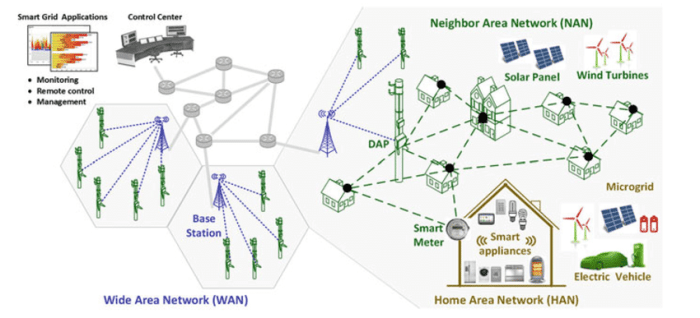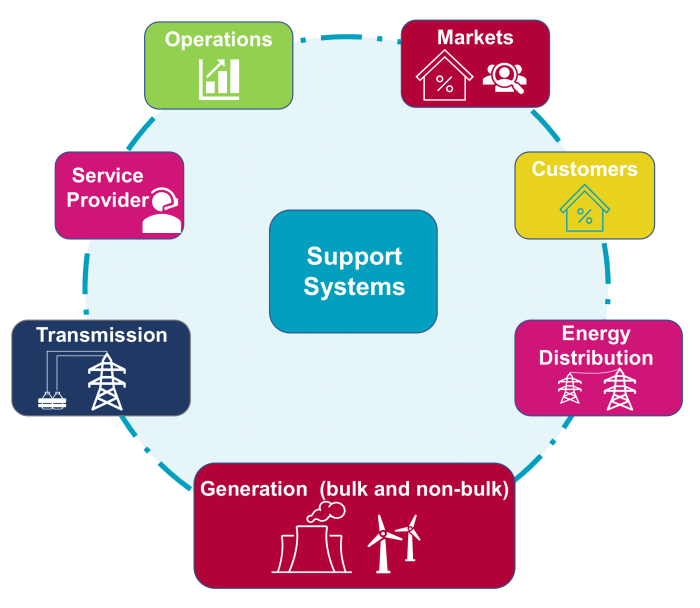Smart grid communication protocols set the stage for this enthralling narrative, offering readers a glimpse into a story rich in detail and brimming with originality from the outset. In today’s interconnected world, the efficient exchange of data is crucial for optimizing energy management and ensuring grid reliability.
As we delve deeper into the realm of smart grid communication protocols, we uncover a landscape filled with diverse standards, impactful technologies, and the constant pursuit of innovation to meet the evolving needs of modern energy systems.
Overview of Smart Grid Communication Protocols
Smart grid communication protocols play a crucial role in the effective functioning of modern energy management systems. These protocols establish the rules and standards for communication between various components of a smart grid, enabling seamless data exchange and control.
Importance of Communication Protocols in Smart Grids
Communication protocols ensure reliable and secure data transmission within smart grid networks. They facilitate real-time monitoring, control, and optimization of energy distribution, leading to improved efficiency and reliability in power delivery.
Types of Communication Protocols Used in Smart Grid Systems
- DLMS/COSEM (Device Language Message Specification/Companion Specification for Energy Metering): Widely used for metering and data exchange in smart grids, offering interoperability and standardized communication.
- IEC 61850: Standard for substation automation and control, enabling seamless integration of devices and systems for efficient grid operation.
- Zigbee: Low-power, wireless protocol suitable for home area networks in smart grids, allowing for communication between smart meters, appliances, and control systems.
- Modbus: Commonly used for industrial automation, allowing for easy integration of legacy devices into smart grid networks.
Advantages and Disadvantages of Various Smart Grid Communication Protocols
- DLMS/COSEM: Advantages include interoperability, data security, and standardized data exchange. However, it may require additional configuration and expertise for implementation.
- IEC 61850: Offers seamless integration, advanced automation capabilities, and real-time communication. Yet, it may be complex to implement and require specialized knowledge.
- Zigbee: Provides low-power consumption, scalability, and flexibility for home area networks. On the downside, it may have limitations in terms of range and data throughput.
- Modbus: Known for its simplicity, compatibility with legacy systems, and cost-effectiveness. However, it may lack advanced security features and high-speed communication.
Common Smart Grid Communication Protocols
When it comes to smart grid communication, there are several popular protocols that play a crucial role in enabling data exchange between various grid components. Let’s dive into the functionalities of some of the most widely used communication protocols like DNP3, IEC 61850, and Modbus, along with examples of their real-world applications and the security measures they implement to safeguard smart grid systems.
DNP3 (Distributed Network Protocol 3)
DNP3 is a widely adopted communication protocol in the utility industry, particularly for SCADA systems. It is designed to facilitate communication between various devices in a supervisory control and data acquisition system. DNP3 supports secure and reliable data exchange, making it ideal for applications where real-time monitoring and control are essential, such as in power distribution networks.
Hey, do you want to improve the power quality in your home or office? Look no further! This comprehensive article on power quality improvement techniques has got you covered with all the information you need to ensure a reliable power supply.
IEC 61850
IEC 61850 is a standard that defines communication protocols for intelligent electronic devices (IEDs) in substations. It enables seamless integration of different devices from multiple vendors, allowing for interoperability and improved efficiency in power system automation. IEC 61850 is commonly used in substation automation, where fast and reliable communication is critical for maintaining grid stability and optimizing operations.
Hey there, looking for some tips and tricks to clean your car interior? Check out this amazing guide on car interior cleaning tips and tricks that will help you keep your ride sparkling clean!
Modbus
Modbus is a simple and robust communication protocol widely used in industrial automation and smart grid applications. It is known for its ease of implementation and compatibility with a wide range of devices. Modbus is often utilized for monitoring and controlling distributed energy resources, such as solar panels and battery storage systems, as well as for collecting data from smart meters in advanced metering infrastructure (AMI) systems.
Protocol Standards and Interoperability

Protocol standards play a crucial role in ensuring seamless communication within smart grid networks. Let’s delve into the significance of standardization bodies like IEEE and IEC in defining smart grid communication standards and the importance of interoperability between different protocols.
Standardization Bodies: IEEE and IEC, Smart grid communication protocols
IEEE (Institute of Electrical and Electronics Engineers) and IEC (International Electrotechnical Commission) are key players in developing and establishing smart grid communication standards. These organizations work to create protocols that are widely accepted and implemented across the industry, promoting uniformity and consistency in communication technologies.
Importance of Interoperability
Interoperability is vital for smart grid communication systems to function effectively. It ensures that devices and systems from different manufacturers can communicate and work together seamlessly, regardless of the specific protocols they use. This interoperability enables efficient data exchange, improved reliability, and enhanced overall performance of the smart grid network.
Ensuring Compatibility and Reliability
Protocol standards are essential for guaranteeing compatibility and reliability in smart grid networks. By adhering to established standards, utilities and other stakeholders can deploy communication technologies with confidence, knowing that they will work cohesively and reliably within the network infrastructure.
Challenges of Achieving Interoperability
Despite the benefits of interoperability, there are challenges associated with integrating diverse communication protocols. Differences in protocols, formats, and communication methods can pose obstacles to seamless interoperability, requiring thorough testing, validation, and coordination to ensure successful integration.
Future Trends in Smart Grid Communication Protocols

The future of smart grid communication protocols is poised to be shaped by emerging technologies that hold the potential to revolutionize grid operations and efficiency. Let’s delve into how IoT, 5G, artificial intelligence, machine learning, and blockchain are set to transform the landscape of smart grid communication protocols.
Integration of IoT and 5G
The integration of Internet of Things (IoT) and 5G technology is expected to bring about significant advancements in smart grid communication protocols. With the massive connectivity and high-speed data transmission capabilities of 5G networks, IoT devices can communicate seamlessly, enabling real-time monitoring and control of grid assets. This integration will enhance grid reliability, resilience, and efficiency, paving the way for a more interconnected and intelligent grid system.
AI and Machine Learning Optimization
Artificial intelligence (AI) and machine learning are increasingly being leveraged to optimize communication protocols in smart grids. Through the analysis of vast amounts of data generated by grid devices and sensors, AI algorithms can identify patterns, predict system behavior, and optimize communication protocols for enhanced grid performance. By continuously learning and adapting to changing grid conditions, AI-powered communication protocols can improve grid operations, mitigate risks, and maximize resource utilization.
Blockchain for Enhanced Security
Blockchain technology holds immense potential to enhance security and trust in smart grid communications. By providing a decentralized and tamper-proof platform for storing transactional data and ensuring data integrity, blockchain can safeguard critical grid information from cyber threats and unauthorized access. The implementation of blockchain-based communication protocols can establish a secure and transparent framework for managing grid transactions, enabling efficient peer-to-peer energy trading and grid management.
Research Trends and Innovations
Research trends and innovations in the field of smart grid communication protocols are driving the development of next-generation solutions. From the exploration of advanced networking technologies to the integration of edge computing and cloud services, researchers are continuously exploring novel approaches to optimize communication protocols for smart grids. By focusing on scalability, interoperability, and resilience, these innovative solutions aim to address the evolving needs of modern grid infrastructure and pave the way for a more efficient and sustainable energy future.
Closing Summary: Smart Grid Communication Protocols

From exploring the functionalities of popular protocols to envisioning the future trends that will shape the landscape, the journey through smart grid communication protocols is one of constant evolution and adaptation. As we embrace the possibilities of emerging technologies and standards, the promise of a more resilient and efficient energy future beckons on the horizon.